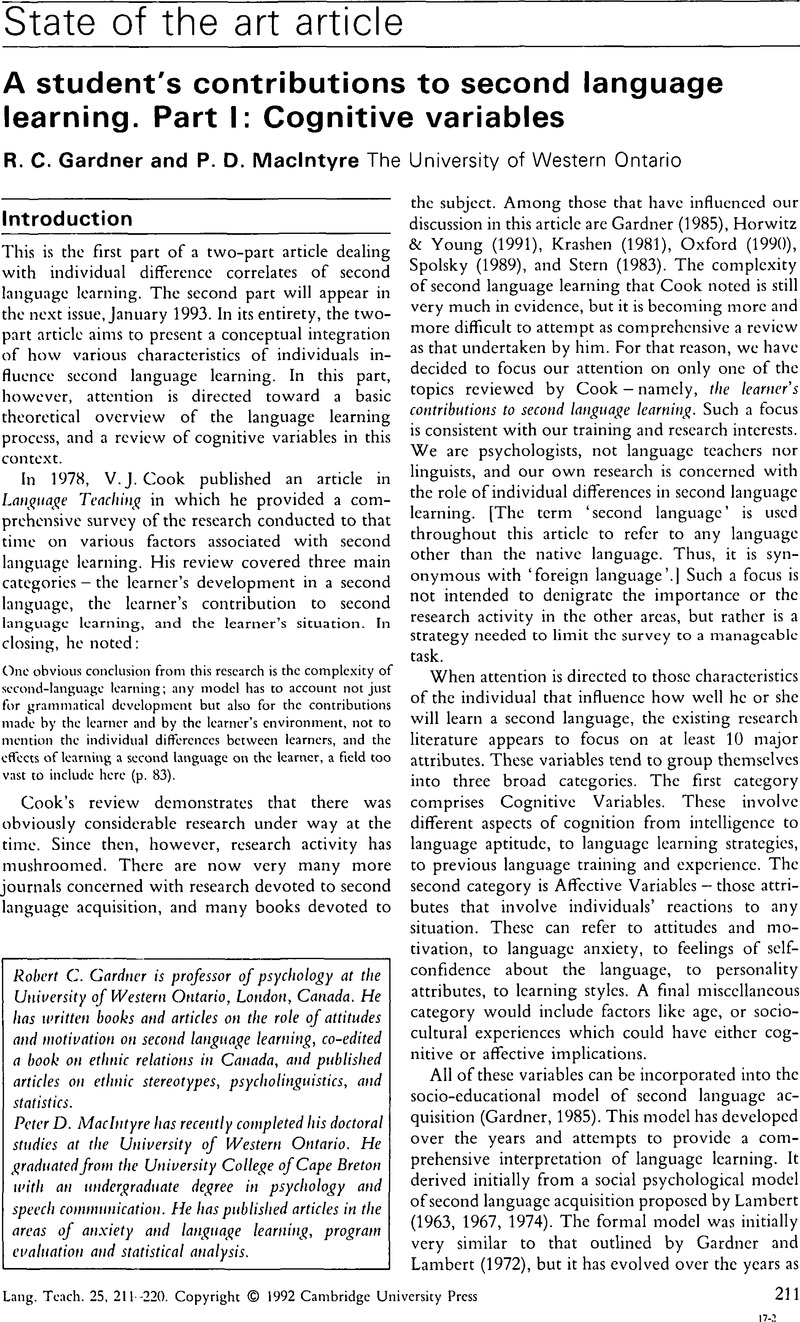Crossref Citations
This article has been cited by the following publications. This list is generated based on data provided by Crossref.
Gardner, R. C.
and
MacIntyre, P. D.
1993.
A student's contributions to second-language learning. Part II: Affective variables.
Language Teaching,
Vol. 26,
Issue. 1,
p.
1.
Atlan, Janet
1993.
Stratégies d’apprentissage et exploitation de textes techniques.
ASp,
Vol. 2,
Issue. ,
p.
121.
Maclntyre, Peter D.
1994.
Toward a Social Psychological Model of Strategy Use.
Foreign Language Annals,
Vol. 27,
Issue. 2,
p.
185.
SPARKS, RICHARD L.
and
GANSCHOW, LEONORE
1995.
A Strong Inference Approach to Causal Factors in Foreign Language Learning: A Response to MacIntyre.
The Modern Language Journal,
Vol. 79,
Issue. 2,
p.
235.
MACINTYRE, PETER D.
1995.
How Does Anxiety Affect Second Language Learning? A Reply to Sparks and Ganschow.
The Modern Language Journal,
Vol. 79,
Issue. 1,
p.
90.
MacIntyre, Peter D.
and
Noels, Kimberly A.
1996.
Using Social‐psychological Variables to Predict The Use of Language Learning Strategies.
Foreign Language Annals,
Vol. 29,
Issue. 3,
p.
373.
MacIntyre, Peter D.
and
Charos, Catherine
1996.
Personality, Attitudes, and Affect as Predictors of Second Language Communication.
Journal of Language and Social Psychology,
Vol. 15,
Issue. 1,
p.
3.
Multhaup, Uwe
1997.
Mental networks, procedural knowledge and foreign language teaching.
Language Awareness,
Vol. 6,
Issue. 2-3,
p.
75.
Coleman, James A.
1997.
Residence abroad within language study.
Language Teaching,
Vol. 30,
Issue. 1,
p.
1.
Trim, J. L. M.
1998.
European perspectives on modern language learning.
Language Teaching,
Vol. 31,
Issue. 3,
p.
136.
Coulombe, Diane
and
Roberts, William L.
2001.
The French-as-a-second-language learning experience of anglophone and allophone university students.
Journal of International Migration and Integration / Revue de l'integration et de la migration internationale,
Vol. 2,
Issue. 4,
p.
561.
Yorozu, Miho
2001.
Interaction with Native Speakers of Japanese: What Learners Say.
Japanese Studies,
Vol. 21,
Issue. 2,
p.
199.
Williams, Marion
Burden, Robert
and
Lanvers, Ursula
2002.
‘French is the Language of Love and Stuff’: Student perceptions of issues related to motivation in learning a foreign language.
British Educational Research Journal,
Vol. 28,
Issue. 4,
p.
503.
Toffoli, Denyze
2003.
De la théorie à la pratique : appliquer des modèles cognitifs de la motivation dans un centre de langues.
ASp,
Vol. 41-42,
Issue. ,
p.
99.
Albert, Ágnes
and
Kormos, Judit
2004.
Creativity and Narrative Task Performance: An Exploratory Study.
Language Learning,
Vol. 54,
Issue. 2,
p.
277.
Shedivy, Sandra L.
2004.
Factors that lead some students to continue the study of foreign language past the usual 2 years in high school.
System,
Vol. 32,
Issue. 1,
p.
103.
Mori, Setsuko
2004.
Significant Motivational Predictors of the Amount of Reading By Efl Learners in Japan.
RELC Journal,
Vol. 35,
Issue. 1,
p.
63.
de Klerk, Vivian
and
Barkhuizen, Gary
2005.
Anticipating language shift: Afrikaans speakers moving to New Zealand.
Language Matters,
Vol. 36,
Issue. 2,
p.
125.
Kiss, Csilla
and
Nikolov, Marianne
2005.
Developing, Piloting, and Validating an Instrument to Measure Young Learners’ Aptitude.
Language Learning,
Vol. 55,
Issue. 1,
p.
99.
SASAKI, MIYUKI
2007.
Effects of Study‐Abroad Experiences on EFL Writers: A Multiple‐Data Analysis.
The Modern Language Journal,
Vol. 91,
Issue. 4,
p.
602.



